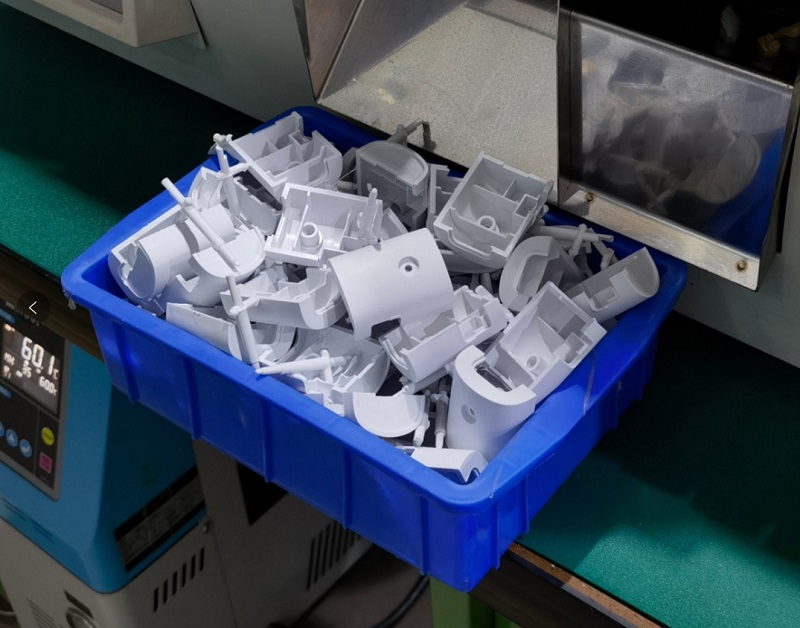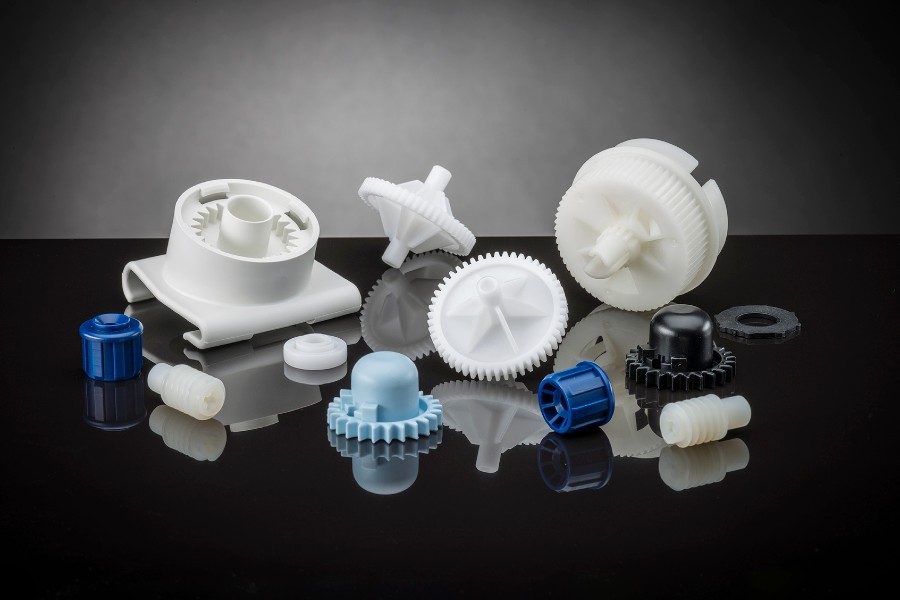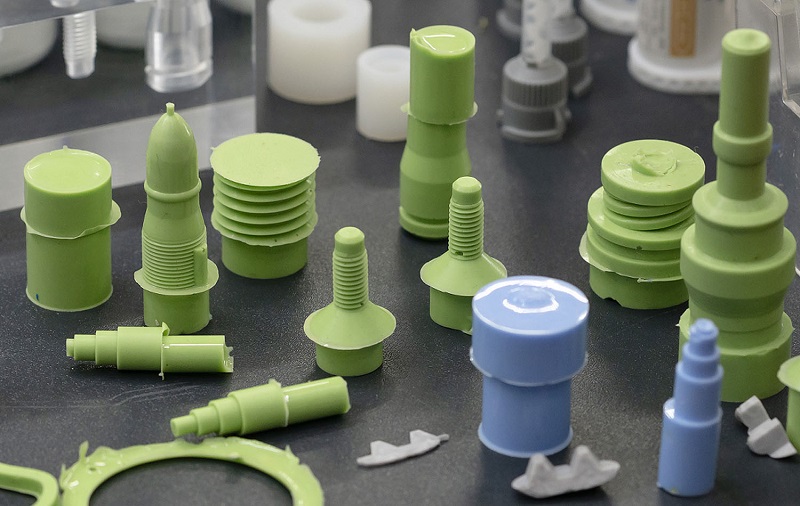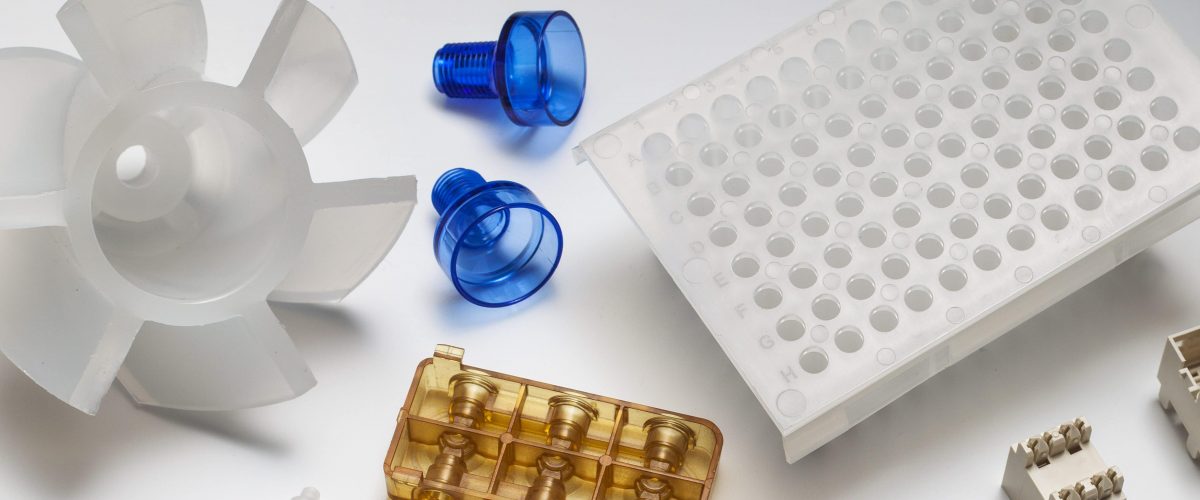Here we will introduce 10 commonly used plastic molding processes. Read to know more details.
1. Injection Molding
2. Blow Molding
3. Extrusion Molding
4. Calendering (sheet, film)
5. Compression Molding
6. Compression Injection Molding
7. Rotational Molding
8. Eight, Plastic Drop Molding
9. Blister Forming
10. Slush Molding
1. Injection Molding
Injection molding’s principle is to add granular or powdery raw materials into the hopper of the injection machine, and the raw materials are heated and melted into a fluid state. Driven by the screw or piston of the injection machine, it enters the mold cavity through the nozzle and the gating system of the mold and hardens and shapes in the mold cavity. Factors affecting the quality of injection molding: injection pressure, injection time, and injection temperature.
Process features:
Advantage:
(1) Short molding cycle, high production efficiency, and easy automation.
(2) It can form plastic parts with complex shapes, precise dimensions, and metal or non-metal inserts.
(3) Stable product quality.
(4) Wide range of adaptation.
Shortcoming:
(1) The price of injection molding equipment is relatively high.
(2) The structure of the injection mold is complex.
(3) The production cost is high, the production cycle is long, and it is not suitable for the production of single-piece and small-batch plastic parts.
Application:
In industrial products, injection molded products include kitchen supplies (garbage cans, bowls, buckets, pots, tableware, and various containers), housings of electrical equipment (hair dryers, vacuum cleaners, food mixers, etc.), toys and games, automobiles Various products of industry, parts of many other products, etc.
1) Insert Injection Molding
Insert molding refers to the injection of resin after loading pre-prepared inserts of different materials into the mold. A molding method in which molten material is bonded to an insert and solidified to form an integrated product.
Process features:
(1) The pre-forming combination of multiple inserts makes the post-engineering of the product unit combination more rational.
(2) The combination of the easy formability and bendability of resin and the rigidity, strength, and heat resistance of metal can be made into complex and exquisite metal-plastic integrated products.
(3) Especially by utilizing the combination of the insulation of resin and the conductivity of metal, the molded products can meet the basic functions of electrical products.
(4) For rigid molded products and curved elastic molded products on rubber sealing pads, after injection molding on the substrate to form an integrated product, the complicated work of arranging the sealing ring can be omitted, making the automatic combination of the subsequent process easier.
2) Two-color Injection Molding
Two-color injection molding refers to the molding method of injecting two different colored plastics into the same mold. It can make the plastic appear in two different colors and also can make the plastic parts present a regular pattern or irregular moiré pattern, so as to improve the usability and aesthetics of the plastic parts.
Process features:
(1) The core material can use low-viscosity materials to reduce the injection pressure.
(2) From the consideration of environmental protection, the core material can use recycled secondary material.
(3) According to different usage characteristics, for example, soft materials are used for the leather layer of thick products, and hard materials are used for the core material. Or the core material can use foam plastic to reduce weight.
(4) Lower-quality core materials can be used to reduce costs.
(5) The skin material or core material can be made of expensive materials with special surface properties, such as anti-electromagnetic wave interference, high electrical conductivity, and other materials. This can increase product performance.
(6) Appropriate combination of skin material and core material can reduce the residual stress of molded products, and increase mechanical strength or product surface properties.
3) Microfoam Injection Molding Process
The Microfoam injection molding process is an innovative precision injection molding technology. The product is filled by the expansion of the pores, and the forming of the product is completed under lower and average pressure.
The microcellular foam molding process can be divided into three stages:
First, the supercritical fluid (carbon dioxide or nitrogen) is dissolved into the hot melt adhesive to form a single-phase solution. Then it is injected into the mold cavity at a lower temperature and pressure through the switch nozzle. A large number of air bubble nuclei are formed in the product due to molecular instability induced by temperature and pressure reduction. These bubble nuclei gradually grow to form tiny holes.
Process features:
(1) Precision injection molding.
(2) Breakthrough many limitations of traditional injection molding. It can significantly reduce the weight of the workpiece and shorten the molding cycle.
(3) The warping deformation and dimensional stability of the workpiece are greatly improved.
Application:
Car dashboards, door panels, air-conditioning ducts, etc.
4) Nano Injection Molding (NMT)
NMT (Nano Molding Technology) is a method of combining metal and plastic with nanotechnology. After the metal surface is nano-treated, the plastic is directly injected onto the metal surface, so that the metal and plastic can be integrally formed. Nano molding technology is divided into two types of processes according to the location of the plastic:
(1) The plastic is an integral molding of the non-appearance surface.
(2) The plastic is integrally formed for the exterior surface.
Process features:
(1) The product has a metallic appearance and texture.
(2) Simplify the design of the mechanical parts of the product, making the product lighter, thinner, shorter, smaller, and more cost-effective than CNC processing.
(3) Reduce production costs and high bonding strength, and greatly reduce the usage rate of related consumables.
Applicable metal and resin materials:
(1) Aluminum, magnesium, copper, stainless steel, titanium, iron, galvanized sheet, brass.
(2) The adaptability of aluminum alloy is strong, including the 1000 to 7000 series.
(3) Resins include PPS, PBT, PA6, PA66, and PPA.
(4) PPS has particularly strong adhesive strength (3000N/c㎡).
Application:
Mobile phone case, laptop case, etc.
Blow Molding
Blow molding is to clamp the molten thermoplastic raw material extruded from the extruder into the mold, and then blow air into the raw material. The molten raw material expands under the action of air pressure and adheres to the wall of the mold cavity. Finally, the method of cooling and solidifying into the desired product shape. Blow molding is divided into two types: film blow molding and hollow blow molding.
1) Film Blowing
Film blowing is to extrude molten plastic into a cylindrical thin tube from the annular gap of the die of the extruder head. At the same time, blow compressed air into the inner cavity of the thin tube from the center hole of the machine head. The thin tube is blown into a tubular film with a larger diameter (commonly known as a bubble tube), and it is coiled after cooling.
2) Hollow Blow Molding
Hollow blow molding is a secondary molding technology that inflates the rubber-like parison closed in the mold cavity into a hollow product by means of gas pressure. And it is a method of producing hollow plastic products. Hollow blow molding varies according to the manufacturing method of the parison, including extrusion blow molding, injection blow molding, and stretch blow molding.
1)) Extrusion blow molding: It is to extrude a tubular parison with an extruder, clamp it in the mold cavity and seal the bottom while it is hot. Then pass compressed air into the inner cavity of the tube blank and blow it into shape.
2)) Injection blow molding: The parison used is obtained by injection molding. The parison remains on the core of the mold. After the mold is closed with the blow mold, the compressed air is passed through the core mold. The parison is inflated, cooled, and the product is obtained after demoulding.
Advantage:
The wall thickness of the product is uniform, the weight tolerance is small, the post-processing is less, and the waste corners are small.
It is suitable for the production of small refined products with large batches.
3)) Stretch blow molding: The parison that has been heated to the stretching temperature is placed in the blow mold. The product is obtained by stretching longitudinally with a stretch rod and stretching horizontally with blown compressed air.
Application:
(1) Film blow molding is mainly used to make plastic thin molds.
(2) Hollow blow molding is mainly used to make hollow plastic products (bottles, packaging barrels, watering cans, fuel tanks, cans, toys, etc.).
Extrusion Molding
Extrusion molding is mainly suitable for the molding of thermoplastics and is also suitable for the molding of some thermosetting and reinforced plastics with good fluidity. The molding process is to use the rotating screw to extrude the heated and molten thermoplastic raw material from the head with the required cross-sectional shape. Then it is shaped by the shaper, and then it is cooled and solidified by the cooler to become a product with the required cross-section.
Process features:
(1) Low equipment cost.
(2) The operation is simple, the process is easy to control, and it is convenient to realize continuous automatic production.
(3) High production efficiency.
(4) The product quality is uniform and dense.
(5) Products or semi-finished products with various cross-sectional shapes can be formed by changing the die of the machine head.
Application:
In the field of product design, extrusion molding has strong applicability. The types of extruded products include pipes, films, rods, monofilaments, flat tapes, nets, hollow containers, windows, door frames, plates, cable cladding, monofilaments, and other special-shaped materials.
Calendering (sheet, film)
Calendering is a method in which plastic raw materials pass through a series of heated rollers to connect them into films or sheets under the action of extrusion and stretching.
Process features:
Advantages:
(1) Good product quality, large production capacity, and automatic continuous production.
(2) Disadvantages: huge equipment, high precision requirements, much auxiliary equipment, and the product width is limited by the length of the roller of the calender.
Application:
It is mostly used in the production of PVC soft film, sheets, artificial leather, wallpaper, floor leather, etc.
Compression Molding
Compression molding is mainly used for the molding of thermosetting plastics. According to the properties of molding materials and the characteristics of processing equipment and technology, compression molding can be divided into two types: compression molding and lamination molding.
1) Compression Molding
Compression molding is the main method for molding thermosetting plastics and reinforced plastics. The process is to pressurize the raw material in a mold that has been heated to a specified temperature so that the raw material melts and flows and fills the mold cavity evenly. After a certain period of time under the conditions of heat and pressure, the raw materials are formed into products. Compression molding machine uses this process.
Process features:
Molded products are dense in texture, precise in size, smooth and smooth in appearance, without gate marks, and have good stability.
Application:
Among industrial products, molded products include electrical equipment (plugs and sockets), pot handles, tableware handles, bottle caps, toilets, unbreakable dinner plates (melamine dishes), carved plastic doors, etc.
2) Lamination Molding
Lamination molding is a method of combining two or more layers of the same or different materials into a whole with a sheet or fibrous materials as fillers under heating and pressure conditions.
Process features:
The lamination molding process consists of three stages: impregnation, pressing, and post-processing. It is mostly used in the production of reinforced plastic sheets, pipes, rods, and model products. The texture is dense and the surface is smooth and clean.
Compression Injection Molding
Compression injection molding is a thermosetting plastic molding method developed on the basis of compression molding, also known as transfer molding. The process is similar to the injection molding process. During compression injection molding, the plastic is plasticized in the feeding cavity of the mold and then enters the cavity through the gating system. Injection molding is plasticized in the barrel of the injection molding machine.
The difference between compression injection molding and compression molding: the compression molding process is to feed the material first and then closes the mold, while injection molding generally requires the mold to be closed before feeding.
Process features:
Advantages: (compared to compression molding)
(1) The plastic has been plasticized before entering the cavity, and it can produce plastic parts with complex shapes, thin walls or great changes in wall thickness, and fine inserts.
(2) Shorten the molding cycle, improve production efficiency, and improve the density and strength of plastic parts.
(3) Since the mold is completely closed before plastic molding, the flash of the parting surface is very thin, so the precision of the plastic part is easy to guarantee, and the surface roughness is also low.
Shortcoming:
(1) There will always be a part of the remaining material left in the feeding chamber, and the consumption of raw materials is relatively large.
(2) The trimming of the gate marks increases the workload.
(3) The molding pressure is larger than that of compression molding, and the shrinkage rate is larger than that of compression molding.
(4) The structure of the mold is also more complicated than that of the compression mold.
(5) The process conditions are stricter than compression molding, and the operation is difficult.
Rotational Molding
Rotational molding is adding plastic raw materials into the mold, and then the mold is continuously rotated along two vertical axes and heated. Under the action of gravity and thermal energy, the plastic raw material in the mold is gradually and uniformly coated and melted, and adhered to the entire surface of the mold cavity. Shaped into the required shape, then cooled and shaped, demoulded, and finally, the product is obtained.
Advantage:
(1) Provide more design space and reduce assembly costs.
(2) Simple modification and low cost.
(3) Save raw materials.
Application:
Water polo, float ball, small swimming pool, bicycle seat pad, surfboard, machine casing, protective cover, lampshade, agricultural sprayer, furniture, canoe, camping vehicle roof, etc.
Eight, Plastic Drop Molding
Drop molding is the use of thermoplastic polymer materials with variable state characteristics, that is, viscous flow under certain conditions, and the characteristics of returning to a solid state at room temperature. And use the appropriate method and special tools to inkjet. In its viscous flow state, it is molded into the designed shape as required and then solidified at room temperature. The technological process mainly includes three stages: weighing glue-dropping plastic-cooling and solidification.
Advantage:
(1) The product has good transparency and gloss.
(2) It has physical properties such as anti-friction, waterproof, and anti-pollution.
(3) It has a unique three-dimensional effect.
Application:
Plastic gloves, balloons, condoms, etc.
Blister Forming
Blister forming, also known as vacuum forming, is one of the thermoplastic thermoforming methods. It refers to the clamping of sheet or plate material on the frame of the vacuum-forming machine. After heating and softening, it will be adsorbed on the mold by vacuum through the air channel on the edge of the mold. After a short period of cooling, molded plastic products are obtained.
Process features:
Vacuum forming methods mainly include concave die vacuum forming, convex die vacuum forming, concave and convex die successive vacuum forming, bubble blowing vacuum forming, plunger push-down vacuum forming, vacuum forming with gas buffer device, etc.
Advantage:
The equipment is relatively simple, the mold does not need to withstand pressure and can be made of metal, wood, or gypsum, with fast forming speed and easy operation.
Application:
Widely used in the internal and external packaging of food, cosmetics, electronics, hardware, toys, crafts, medicine, health care products, daily necessities, stationery, and other industries; disposable cups, various cup-shaped cups, etc., reeding trays, seedling trays, degradable fast food boxes.
Slush Molding
Slush molding is pouring paste plastic (plastisol) into a mold (concave or female mold) that is preheated to a certain temperature. The paste plastic close to the inner wall of the mold cavity will gel due to heat, and then pour out the paste plastic that has not gelled. The method of heat-treating (baking and melting) the paste plastic attached to the inner wall of the mold cavity, and then cooling it to obtain a hollow product from the mold.
Process features:
(1) Low equipment cost, and high production speed.
(2) The process control is simple, but the accuracy of the thickness, and quality (weight) of the product is poor.
Application:
It is mainly used for high-end car dashboards and other products that require high hand feeling and visual effects, slush plastic toys, etc.
Post time: Apr-19-2023











